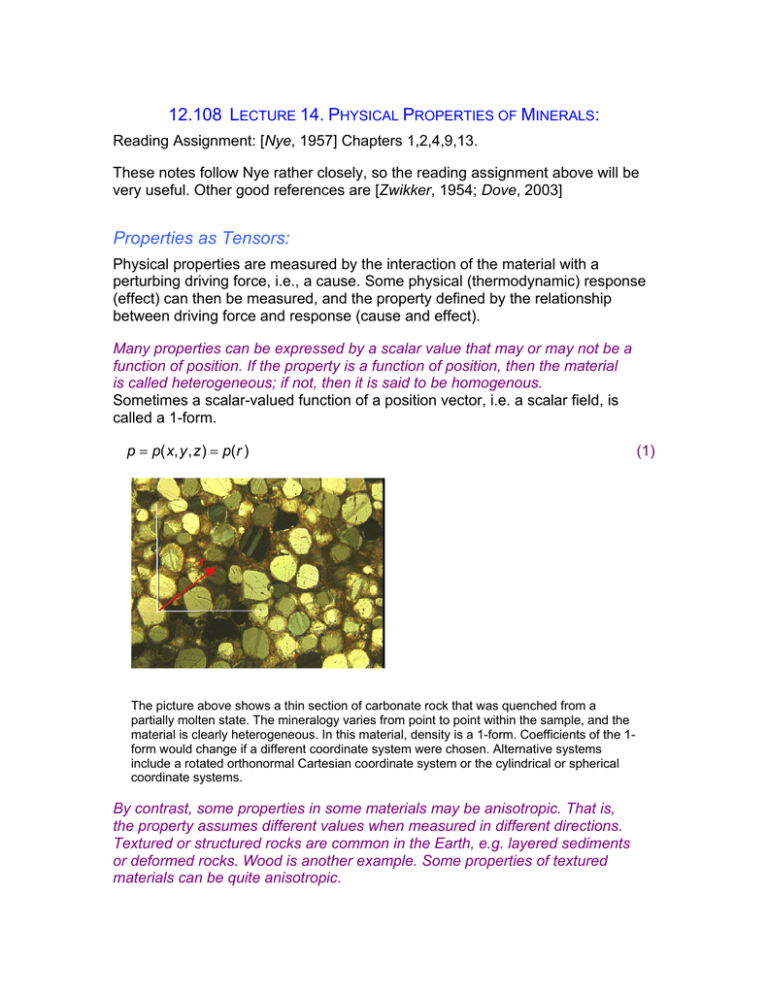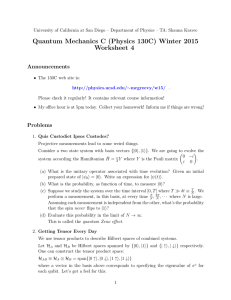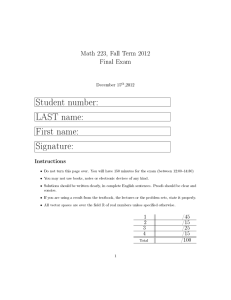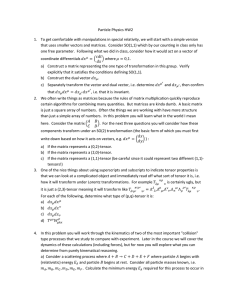12.108 L 14. P
advertisement

12.108 LECTURE 14. PHYSICAL PROPERTIES OF MINERALS: Reading Assignment: [Nye, 1957] Chapters 1,2,4,9,13. These notes follow Nye rather closely, so the reading assignment above will be very useful. Other good references are [Zwikker, 1954; Dove, 2003] Properties as Tensors: Physical properties are measured by the interaction of the material with a perturbing driving force, i.e., a cause. Some physical (thermodynamic) response (effect) can then be measured, and the property defined by the relationship between driving force and response (cause and effect). Many properties can be expressed by a scalar value that may or may not be a function of position. If the property is a function of position, then the material is called heterogeneous; if not, then it is said to be homogenous. Sometimes a scalar-valued function of a position vector, i.e. a scalar field, is called a 1-form. p = p( x, y , z ) = p(r ) The picture above shows a thin section of carbonate rock that was quenched from a partially molten state. The mineralogy varies from point to point within the sample, and the material is clearly heterogeneous. In this material, density is a 1-form. Coefficients of the 1form would change if a different coordinate system were chosen. Alternative systems include a rotated orthonormal Cartesian coordinate system or the cylindrical or spherical coordinate systems. By contrast, some properties in some materials may be anisotropic. That is, the property assumes different values when measured in different directions. Textured or structured rocks are common in the Earth, e.g. layered sediments or deformed rocks. Wood is another example. Some properties of textured materials can be quite anisotropic. (1) Some driving forces can be represented by scalars, and some by vectors or higher order tensors; similarly, responses may be scalars, vectors or tensors; the rank of the driving force (or response) is then said to be 0, 1, 2, or higher. Because of the symmetry (and anisotropy) of the atomic structure of minerals, the response of the crystal lattice to a driving force may vary as a function of the direction within the crystal. The property is said to be anisotropic. Alternatively, the property may relate a driving force to response of with a different rank, In these cases, the property may not be a simple scalar. A driving force – here it is a vector, e.g., an electric or magnetic field – is applied to a crystal. The response or effect, also a vector, may not be collinear with the force. In the case of an electric field, the response might be a current density. If the response does differ in direction, then the physical property cannot be represented as a scalar and must be described as a second rank tensor. A few physical properties: Response [Rank]* Property [Rank] Driving force [Rank] Light (freq., ampl.) [0] Entropy [0] Acceleration [0] Elec. Current [1] Heat flow [1] Strain [2] Stress [2] Stress [2] Strain [2] Color [0] Heat of polarization [0] Mass-1[0] Elect. Conductivity [2] Therm. Conductivity [2] Therm. expansion [2] Conv. Piezoelectric [3] Elast. Stiffness [4] Elast. Compliance [4] Light (freq..ampl) [0] ∆Temperature [0] Force [1] Elec. Field (Pot. Gradient) [1] Temperature gradient (∇T) [1] ∆Temperature [0] Electric polarization [2] Strain [2] Stress [2] Can you add other properties? * A scalar has rank 0, a vector has rank 1, a second order tensor has rank 2, and so on. SCALARS, VECTORS, AND TENSORS Vector and Tensor Components A scalar can be represented by a single number, a vector by a set of three numbers, and a second rank tensor by a set of nine numbers; these numbers are the components of the vector or tensor. Any vector can be expressed mathematically by using a set of three components which are the projections of the vector onto the basis vectors of the coordinate system being used. The ith component of a vector E is given by Ei = E.e i where e i are the basis vectors. (2) Obviously, the values of the components will be affected by the choice of basis vectors. Once again, consider the difference in the components of a given vector as expressed in cylindrical or spherical coordinates. Several different notations are common. r ⎧ V ⎪ ⎪v1e1 + v 2 e 2 + v 3 e3 ⎪ V=⎨ [v1 v 2 v 3 ] ⎪ vi ⎪ ⎪⎩ v i ei To conform to Nye’s treatment we use the indicial notation with the convention that repeated indices are summed from 1 to 3 (the Einstein notation) and free subscripts can assume any value from 1 to 3. A further simplification will be that we consider only orthonormal Cartesian coordinate axes. Examples of vector objects: Force, acceleration, electric field, temperature gradients (indeed, the directional gradient of anything), magnetic fields. Although the numerical values of the components may change when the coordinate axes are changed, vectors have two properties that are invariant to a transformation of coordinate systems: magnitude and direction. Vector Transformations: Consider the components of a vector. How do the components change as the coordinate system is rotated? v If the original vector is given as vi, then V = v1e1 + v 2 e 2 + v 3 e3 = v i e i . The new components are the projections on the new axes: v 'i = V.e 'i a11 a12 a = a21 a22 a13 a23 a31 a32 a33 1st subscript gives identity of the old axis. 2nd subscript gives new. Suppose that we construct a 3x3 matrix a such that aij = e 'i. e j . The aij are direction cosines between the “old” j axis and the “new” I axis. Then from the two equations above, we see that v 'k = akl v l . These relations are the transformation laws of a vector. Notice that the first subscript in the direction cosine matrix gives the identity of the new axis, while the second gives the identity of the old axis. Because both axes are orthonormal, spherical trigonometry requires that a1k 2 = 1 and a1k a2k = 0 . The vector transformation law implies that the magnitude and direction of the vector is not changed by the transformation of the axes. Conversely, if the magnitude and direction of the vector is not changed, then the transformation law must be obeyed. So a vector has three components (in a 3-d Euclidean space) and it has two invariants: magnitude and direction. Similar statements may be made about higher rank tensors. Summary: Tensors of Rank n: Object Rank Components # Trans. Law Invariants Example Scalar 0 K=k 1 ----- Magnitude Density Vector 1 Vi 3 v 'k = akl v l Magnitude, Direction Pyroelectricity Heat of polarization 2nd Rank Tens. 2 Tij 9 (T 'kl ) = aki alj (Tij ) Trace Deviator Determinant Elec. Conductivity Heat Conductivity Thermal expansion 3rd Rank Tens. 3 Pijk 27 P 'qrs = aqi arj ask Pijk (4) Conventional piezeoelectric effect 4th Rank Tens. 4 Eijkl 81 E 'qrst = aqi arj ask atl Eijkl (5) Elastic compliance SECOND RANK TENSOR PROPERTIES Many properties are tensors that relate one vector to another or relate a scalar to a tensor.If the driving force and the response are collinear the property can be expressed as a scalar, but when that are not, the property must be expressed as a second rank tensor. Driving forces and responses may also be second rank tensors: e.g., stress, strain. Equilibrium Properties of Rank 2: Response Dielect. Displacement D Polarization P Mag. Induction B Mag. Intensity I Property Elec. Permittivity K Dielect. Suscept. χ Mag. Permeability µ Mag. Suscept. Ψ Driving force Elec. Field E or ∇V Elec. Field E or ∇V Mag. Field H Mag. Field H Transport Properties of Rank 2: Response Current Density j Heat flux q Fluid flux Q Chem. flux J Property Elec. Conductivity σ Thermal conduct. k Fluid permeability K Diffusivity D Driving force Elec. Field E or ∇V Temp. grad. ∇T Pressure grad. ∇P Chem. pot. grad. ∇µ Notation A second rank tensor can be written in several different notations: ⎧ ⎪ ⎪ T ⎪ %% ⎪ T=⎨ t ij ⎪t t ⎪ 11 21 ⎪ t 21 t 22 ⎪ ⎪⎩ t31 t32 t31 t23 t33 In the indicial notation, a tensor of rank n can be written as rabc ...n , where each index can be 1, 2, or 3. The number of components is 3n (in a 3-d space). Just as the components of a vector will change numerically when the coordinate system is changed, the components of the tensor will change. But, tensors have invariants, too. In the case of a tensor of rank 2 there are three quantities that are invariant to coordinate transformations. Transformation of a second rank tensor: A second rank tensor may be thought of as a vector-valued function of a vector. Consider a tensor that is a linear relation between two vectors: p = Tq % %% % The tildes under the variables emphasize the rank of the objects. So the components of q , i.e., qi are mapped onto the components of p , i.e., pj: % % If p and q are collinear, then T is a scalar; otherwise, it must be a tensor of % % rank two. In indicial notation the tensor relation can be written as p j = T ji qi . We ask the question: How do the components of T change as the coordinate system is rotated? Using the indicial notation and the convention that the components in the rotated axes have primes: p ' j = T ' ji q 'i . From the vector transformation law, p 'k = aki pi = aki (Tiji qi ) , but also qi = a ji q ' j . So, p 'k = aki pi = aki (Tiji a ji q ' j ) = aki a ji (Tiji ) q ' j Finally, by comparison, we see that (T 'kl ) = aki alj (Tij ) This equation is the transformation law of a second rank tensor. It may be regarded as a definition, or as resulting from the fact that the tensor is a vector-valued function of a tensor. The tensor transformation law may be used to obtain the values of the property as the direction of the cause (driving force) changes. In the transformation law above, the repeated indices (I, j) are called dummy indices. The indices that are not repeated are free indices. (3) SOME IMPORTANT REMARKS ABOUT SYMMETRIC SECOND-RANK TENSORS: 1. Some, but not all, properties are symmetric. That is, Tij = T ji . The proof of this symmetry is always obtained from arguments about the physics of the property or, in the case of strain, from definition. 2. If a 2nd rank tensor is symmetric, there are 3 mutually perpendicular directions, for which cause and effect are in the same direction. These are called the principal directions 3. If the tensor is written in terms of a coordinate system composed of these three vectors, then the components of the vector are particularly simple: TI 0 0 0 TII 0 0 0 TIII 4. The values along the diagonal are called the principal values. For a proof that such directions and principal values always exist, see [Nye, 1957, page 41-43; Malvern, 1969]. † 5. Regardless of the coordinate basis chosen, the tensor must contain the symmetry elements of the point group appropriate for the crystal (Neumann’s Principle). It may, however, contain more symmetry. Some questions: Write out the equation p = Tq explicitly. Why should Neumann’s principle hold? Of the driving forces given in the table of 2nd rank properties above, which are symmetric and why? Are the three invariants of the 2nd rank tensor related to the principal values? How? † If p j = T ji qi , then in the principal direction representation, T ji qi = λqi ⇒ T ji − λ qi = 0. The principal directions exist if solutions to the equation:: Tij − λδ ij = 0 can be found. Magnitude of a Property in a Given Direction: Consider electrical conductivity, a symmetric second-rank physical property that relates the electric field, B, to the current density, j. In indicial notation, j i = σ ij E j . (Ohm’s law) (4) Assume that the coordinate axes are the principal directions. (What does the tensor look like in this representation?) Because the property isn’t isotropic, the driving force and the effect are not e2 in the same direction. Suppose that e1 we wish to measure the value of the property in the same direction as E. Call this quantity σ E ; note that it is a scalar and can be defined as the ratio of the magnitude of the current density parallel to E, to the magnitude of E. σE jE (5) E Using the properties of the dot product: σ E = 1 E ⎛ j.E ⎞ . Then the components of ⋅⎜ ⎜ E ⎟⎟ ⎝ ⎠ Ei = E l i where l i are direction cosines. 0 ⎤ ⎡ E l1 ⎤ ⎡σ I 0 ⎢ ⎥ ⎢ But j i = σ ij E j = ⎢ 0 σ II 0 ⎥⎥ ⎢ E l 2 ⎥ = ⎡⎣σ I E l1 σ II E l 2 σ III E l 3 ⎤⎦ . Finally, ⎢⎣ 0 0 σ III ⎥⎦ ⎢⎣ E l 3 ⎥⎦ plugging into (5) implies that the magnitude of a property in a direction li is . σ E = σ I l12 + σ II l 22 + σ III l 32 (6) Resources: Dove, M.T., Structure and Dynamics: An Atomic View of Materials, 334 pp., Oxford University Press, Oxford, 2003. Malvern, L.E., Introduction to the Mechanics of a Continuous Medium, Prentice Hall, Englewood Cliffs, NJ, 1969. Nye, J.F., Physical Properties of Crystals, 322 pp., Oxford University Press, Oxford, UK, 1957. Zwikker, C., Physical Properties of Solid Materials, 300 pp., Pergamon Press, London, 1954.







